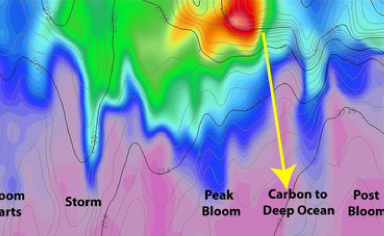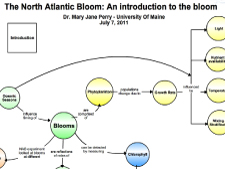|
||
Click this image for an interactive introduction to the North Atlantic Bloom |
The phytoplankton in this bloom play a significant ecological role as part of the carbon cycle, taking carbon dioxide from the atmosphere and starting the process of storing it in the ocean. In 2008, Dr. Mary Jane Perry and researchers from the University of Washington Applied Physics Laboratory, Woods Hole Oceanographic Institute, and Dalhousie University in Nova Scotia set out to better understand the mechanics and importance of this seasonal event.
For this project, traditional ship-based instruments were supplemented with new autonomous platforms, including Seagliders and Lagrangian Floats, and innovative sensors to detect chlorophyll fluorescence, optical backscattering, beam attenuation, oxygen and nitrogen (in addition to the standard temperature, conductivity, and pressure measurements). In all, over 60 data channels were sampled to give a time-space resolved picture of physical, biological, and chemical properties.
"What we're learning about eddies is that they're a critical part
of life in the ocean. They shape ocean ecosystems in countless ways."-Mary Jane Perry |



